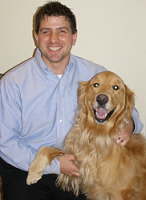Pain in My Neck!
by Dr. Jim Hendricks, Freeport Integrated Health Center, Freeport, Maine Many patients that make their way in to my office complain of neck and upper back pain. Most deal with the pain until starts to compromise their daily activities and some think, "it will just go away on its own." In any case there are many structures with in the neck, which can cause neck and upper back pain.
Many patients that make their way in to my office complain of neck and upper back pain. Most deal with the pain until starts to compromise their daily activities and some think, "it will just go away on its own." In any case there are many structures with in the neck, which can cause neck and upper back pain.
The neck region of your spine is referred to as the cervical spine and it begins at the base of your skull. There seven vertebrae make up t he cervical spine and there are 8 sets of cervical nerves as well. The individual cervical vertebrae are labeled C1, C2, C3, C4, C5, C6 and C7 while the nerves are also labeled C1 through C8. Starting with C2-3 there is a disc that lies between each adjacent vertebrae and function to maintain a changeable space in between each cervical vertebrae, aid in flexibility and serve to absorb the shock associated with gravity and movement. The cervical spine has a lordotic curve or a backward "C" shape which aids it ability to maintain and stabilize the head.
The purpose of the cervical spine is to protect the spinal cord and support the head while enabling the head and neck to move. There are various ligaments, tendons, and muscles help to support and stabilize the cervical spine. Ligaments connect bones together and in the cervical spine serve to support the vertebral joints to provide a rigid stability and prevent excessive motion that could result in serious injury. The muscles in the cervical region use the cervical vertebrae as attachment points from which they create force and achieve movement, provide spinal balance and stability. The muscles contract and relax in response to nerve impulses originating in the brain.
Injuries or mild trauma to the cervical spine can cause anything from a serious or life-threatening medical emergency to simple sprains/strains. These injuries can exhibit many symptoms but the most common are pain, loss of movement, muscular spasm or hypertonicity (tightness), numbness, weakness or tingling. Typically sensations of numbness or tingling or radiating pain into the arms or hands are symptoms that may develop when one or more spinal nerves are injured, irritated, or stretched. This is common when a cervical disc bulges or ruptures. While I have seen many serious cases of cervical spine injury, the majority of the cases I see in practice are simple sprains/strains or chronic muscular hypertonicity and pain caused from cumulative trauma or repetitive activities. But my advice to you is no matter how big or how small you may think your problem is, it will never "just go away on its on" and you should seek medical care.
When there is an injury to the cervical spine or the muscles, which attached to the spine, typically the first sign is restricted range of motion and pain. This restricted motion within the cervical spine not only affects the length and function of all the muscles but the vertebrae and the joint it creates with the adjacent vertebrae. This can cause further muscle tightness or spasm and lead to an increased loss of range of motion and pain. Pain from the cervical discs is usually the by product of years of cumulative trauma or what I like to call "patient use and abuse." Disc injuries are typically caused by years of repetitive stress/strain, injury or possibly years improper spinal alignment. A bulging disc can put pressure on the cervical spinal nerve, the spinal cord or both depending on its severity leading to the various symptoms explained previously.
In any of the above-mentioned causes of neck pain, I have had great success using a combined treatment protocol of physiotherapy modalities, spinal manipulation, massage therapy and rehabilitative strengthening. In some cases with patients suffering from bulging or ruptured discs conservative therapy is not enough and if necessary may warrant surgery. If you have been suffering from neck pain, please contact me for more information.
Dr. Jim Hendricks is a doctor of chiropractic at Freeport Integrated Health Center in Freeport. His undergraduate education is in Sports Medicine and he is Certified Strength and Conditioning Coach. For more information go to https://www.freeport-chiro.com/
Herb's Tips and More
-
 Did you know that you can make soap, candles and lotion with your herbs?
Did you know that you can make soap, candles and lotion with your herbs? -
 Never take any herb identity for granted. The best way to be sure that you are using the right kind of herb is by buying it.
Never take any herb identity for granted. The best way to be sure that you are using the right kind of herb is by buying it. -
 Excellent health articles whether you are looking for information or inspiration regarding preventive health or are dealing with a medical
challenge.
Excellent health articles whether you are looking for information or inspiration regarding preventive health or are dealing with a medical
challenge.









